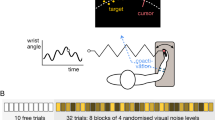Abstract
The role of propriomuscular information in kinaesthetic sensation was studied. Experiments were carried out on human subjects in whom kinaesthetic illusions were induced by applying tendon vibration with a variable frequency. Six patterns of frequency modulation were used, four of which had an arbitrary form and the other two mimicked natural Ia discharges. The results show that the shape of the illusory movements recorded depended on the type of vibratory pattern used. A mathematical model for the propriomuscular information decoding process is proposed. It takes into account both the agonist and antagonist muscle spindle populations as sources of kinaesthetic information and is based on the assumption that position and velocity information are additively combined. The experimental data show a good fit with the theoretical data obtained by means of model simulation, thus validating our initial hypothesis. Various aspects of the experimental results and the hypotheses involved in the model are discussed.
Similar content being viewed by others
References
Bonnet M, Roll JP, Lacour M (1973) High frequency activation of myotatic pathway in man and illusion of movement. Electroencephal Clin Neurophysiol 34:810
Burgess PR, Wei JY, Clark FJ, Simon J (1982) Signaling of kinaesthetic information by peripheral sensory receptors. Annu Rev Neurosci 5:171–187
Burke D, Hagbarth K-E, Löfsted L, Wallin BG (1976a) The responses of human muscle spindle endings to vibration of noncontracting muscles. J Physiol 261:695–711
Burke D, Hagbarth K-E, Löfsted L, Wallin BG (1976b) The responses of human muscle spindle endings to vibration during isometric contraction. J Physiol 261:673–693
Crowe A, Matthews PBC (1964) The effects of stimulation of static and dynamic fusimotor fibres on the response to stretching of primary endings of muscle spindles. J Physiol 174:109–131
Crowe A, Naeije M, Tanke RHJ (1980) A method for the interpretation of signals in afferent nerves from muscle spindles. Biol Cybern 37:187–193
Eklund G (1972) Position sense and state of contraction: the effects of vibration. J Neurol Neurosurg Psychiatr 35:606–611
Emonet-Denand F, Hunt CC, Laporte Y (1985) Fusimotor after-effects on responses of primary endings to test dynamic stimuli in the cat muscle spindles. J Physiol 360:187–200
Feldman AG, Latash ML (1982) Afferent and efferent components of joint position sense; interpretation of kinaesthetic illusions. Biol Cybern 42:205–214
Gandevia SC (1985) Illusory movements produced by electrical stimulation of low-threshold muscle afferents from the hand. Brain 108:965–981
Gandevia SC, Hall LA, McCloskey DI, Potter EK (1983) Proprioceptive sensation at the terminal joint of the middle finger. J Physiol 335:507–517
Gilhodes JC, Roll JP, Tardy-Gervet MF (1986) Perceptual and motor effects of agonist-antagonist muscle vibration in man. Exp Brain Res 61:395–402
Goodwill GM, McCloskey DI, Matthews PBC (1972) The contribution of muscle afferents to kinaesthesia shown by vibration induced illusions of movement and by the effects of paralysing joint afferents. Brain 95:705–748
Hagbarth KE (1973) The effects of muscle vibration in normal man and in patients with motor disorders, In: Desmedt JE (eds) New development in EMG and clinical neurophysiology, vol 3. Karger, Basel, pp 428–443
Houk JC, Rymer WZ, Crago PE (1981) Nature of the dynamic response and its relation to the high sensitivity of muscle spindles to small changes in length. In: Taylor, Prochazka (eds) Muscle receptors and movement, McMillan, London Basington, pp 33–43
Hulliger M (1984) The mammalian muscle spindle and its central control. Rev Physiol Biochem Pharmacol 101:1–110
Hunt CC, Ottoson D (1976) Initial burst of primary endings of isolated mammalian muscle spindles. J Neurophysiol 39:324–330
Jones LA (1988) Motor illusions: what do they reveal about proprioception? Psychol Bull 103:72–86
Macefield G, Gandevia SC, Burke D (1990) Perceptual responses to microstimulation of single afferents innervating joints, muscle and skin of the human hand. J Physiol 429:113–129
Matthews PBC (1972) Mammalian muscle receptors and their central actions. Arnold Pub. London
Matthews PBC (1981a) Evolving views of the internal operation and functional role of the muscle spindle. J Physiol 321:1–30
Matthews PBC (1981b) Muscle spindles: their messages and their fusimotor supplies. In: Brookhart JM, Moutcastle VB, Brooks VB (eds) Motor control, part I, Amer Physiol Soc (Handbook of Physiology, vol 2), pp 189–228
Matthews PBC (1982) Where does Sherrington's “muscular sense” originate? Muscles, joints, corollary discharges? Annu Rev Neurosci 5:189–218
Matthews PBC, Stein RB (1969) The regularity of primary and secondary muscle spindle afferent discharges. J Physiol 202:59–82
Ribot E, Roll JP, Vedel JP (1986) Efferent discharges recorded from single skeletomotor and fusimotor fibres in man. J Physiol 375:251–268
Roll JP, Vedel JP (1982) Kinaesthetic role of muscle afferents in man, studied by tendon vibration and microneurography. Exp Brain Res 47:177–190
Roll JP, Gilhodes JC, Tardy-Gervet MF (1980) Effets perceptifs et moteurs des vibrations chez l'homme normal: mise en évidence d'une réponse des muscles antagonistes. Arch Ital Biol 118:51–71
Roll JP, Vedel JP, Ribot E (1989) Alteration of proprioceptive messages induced by tendon vibration in man: a microneurographic study. Exp Brain Res 76:213–222
Sherrington CS (1990) The muscular sense. In: Shäfer EA (eds) Shäfer textbook of Physiology, Edinburgh London, Pentland, pp 1002–25
Sittig AC, Denier Van Der Gon JJ, Gielen CCAM (1987) The contribution of afferent information on position and velocity to the control of slow and fast human forearm movements. Exp Brain Res 67:33–40
Author information
Authors and Affiliations
Rights and permissions
About this article
Cite this article
Gilhodes, J.C., Coiton, Y., Roll, J.P. et al. Propriomuscular coding of kinaesthetic sensation. Biol. Cybern. 68, 509–517 (1993). https://doi.org/10.1007/BF00200810
Received:
Accepted:
Issue Date:
DOI: https://doi.org/10.1007/BF00200810




